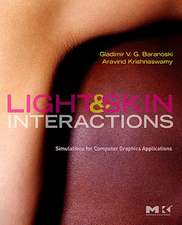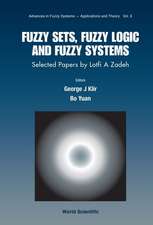Design and Modeling for Computer Experiments: Chapman & Hall/CRC Computer Science & Data Analysis
Autor Kai-Tai Fang, Runze Li, Agus Sudjiantoen Limba Engleză Hardback – 14 oct 2005
Written by authors with strong academic reputations and real-world practical experience, Design and Modeling for Computer Experiments is exactly the kind of treatment you need. The authors blend a sound, modern statistical approach with extensive engineering applications and clearly delineate the steps required to successfully model a problem and provide an analysis that will help find the solution. Part I introduces the design and modeling of computer experiments and the basic concepts used throughout the book. Part II focuses on the design of computer experiments. The authors present the most popular space-filling designs - like Latin hypercube sampling and its modifications and uniform design - including their definitions, properties, construction and related generating algorithms. Part III discusses the modeling of data from computer experiments. Here the authors present various modeling techniques and discuss model interpretation, including sensitivity analysis. An appendix reviews the statistics and mathematics concepts needed, and numerous examples clarify the techniques and their implementation.
The complexity of real physical systems means that there is usually no simple analytic formula that sufficiently describes the phenomena. Useful both as a textbook and professional reference, this book presents the techniques you need to design and model computer experiments for practical problem solving.
| Toate formatele și edițiile | Preț | Express |
|---|---|---|
| Paperback (1) | 265.29 lei 6-8 săpt. | |
| CRC Press – 30 iun 2020 | 265.29 lei 6-8 săpt. | |
| Hardback (1) | 741.91 lei 6-8 săpt. | |
| CRC Press – 14 oct 2005 | 741.91 lei 6-8 săpt. |
Din seria Chapman & Hall/CRC Computer Science & Data Analysis
-
 Preț: 436.36 lei
Preț: 436.36 lei -
 Preț: 356.64 lei
Preț: 356.64 lei - 18%
 Preț: 704.73 lei
Preț: 704.73 lei - 15%
 Preț: 674.03 lei
Preț: 674.03 lei -
 Preț: 370.85 lei
Preț: 370.85 lei -
 Preț: 430.17 lei
Preț: 430.17 lei - 12%
 Preț: 312.77 lei
Preț: 312.77 lei - 25%
 Preț: 427.84 lei
Preț: 427.84 lei - 20%
 Preț: 607.20 lei
Preț: 607.20 lei - 30%
 Preț: 288.69 lei
Preț: 288.69 lei -
 Preț: 386.88 lei
Preț: 386.88 lei - 15%
 Preț: 481.58 lei
Preț: 481.58 lei - 15%
 Preț: 485.98 lei
Preț: 485.98 lei - 22%
 Preț: 352.95 lei
Preț: 352.95 lei - 31%
 Preț: 265.29 lei
Preț: 265.29 lei - 20%
 Preț: 394.99 lei
Preț: 394.99 lei - 18%
 Preț: 1110.92 lei
Preț: 1110.92 lei - 20%
 Preț: 473.30 lei
Preț: 473.30 lei - 11%
 Preț: 305.52 lei
Preț: 305.52 lei - 25%
 Preț: 773.33 lei
Preț: 773.33 lei
Preț: 741.91 lei
Preț vechi: 927.39 lei
-20% Nou
Puncte Express: 1113
Preț estimativ în valută:
141.97€ • 151.81$ • 118.37£
141.97€ • 151.81$ • 118.37£
Carte tipărită la comandă
Livrare economică 18 aprilie-02 mai
Preluare comenzi: 021 569.72.76
Specificații
ISBN-13: 9781584885467
ISBN-10: 1584885467
Pagini: 302
Ilustrații: 60 b/w images, 47 tables, 13 halftones and 1040 equations
Dimensiuni: 156 x 234 x 22 mm
Greutate: 0.72 kg
Ediția:New.
Editura: CRC Press
Colecția Chapman and Hall/CRC
Seria Chapman & Hall/CRC Computer Science & Data Analysis
Locul publicării:Boca Raton, United States
ISBN-10: 1584885467
Pagini: 302
Ilustrații: 60 b/w images, 47 tables, 13 halftones and 1040 equations
Dimensiuni: 156 x 234 x 22 mm
Greutate: 0.72 kg
Ediția:New.
Editura: CRC Press
Colecția Chapman and Hall/CRC
Seria Chapman & Hall/CRC Computer Science & Data Analysis
Locul publicării:Boca Raton, United States
Public țintă
ProfessionalCuprins
PART I: AN OVERVIEW: Introduction. PART II: DESIGNS FOR COMPUTER EXPERIMENTS: Latin Hypercube Sampling and its Uniform Experimental Design
Optimization in Construction of Designs FOR Computer Experiments. PART III: MODELING FOR COMPUTER EXPERIMENTS: Metamodeling. Model Interpretation
Functional Response. APPENDIX: Some Useful Concepts in Statistics and Matrix Algebra. Abbreviation. References. Index. Author Index.
Optimization in Construction of Designs FOR Computer Experiments. PART III: MODELING FOR COMPUTER EXPERIMENTS: Metamodeling. Model Interpretation
Functional Response. APPENDIX: Some Useful Concepts in Statistics and Matrix Algebra. Abbreviation. References. Index. Author Index.
Notă biografică
Kai-Tai Fang, Runze Li, Agus Sudjianto
Recenzii
". . . very well-organized text . . . makes a very valuable contribution to the field. I highly recommend it for anyone trying to learn design and modeling techniques for computer experiments. In particular, it will be a useful professional reference for scientists and engineers in practicing computer experiments, a comprehensive resource book for statisticians interested in developing new techniques for designing and modeling computation experiments, and an excellent book for undergraduate and graduate students. The authors’ careful and thorough presentation style makes the book a very enjoyable read."
– Hao Helen Zhang, North Carolina State University, in JASA, December 2008
– Hao Helen Zhang, North Carolina State University, in JASA, December 2008
Descriere
This book blends a modern statistical approach with extensive engineering applications and clearly delineates the steps for successfully modeling a problem and analyzing it to find the solution. It introduces basic concepts, then fully examines computer experiment design. The authors present the popular space-filling designs - like Latin hypercube sampling - including their properties, construction, and generating algorithms. Discussion then moves to the modeling of data from computer experiments. Here the authors present various modeling techniques and discuss model interpretation, including sensitivity analysis. Numerous examples clarify the techniques and their implementation.




















